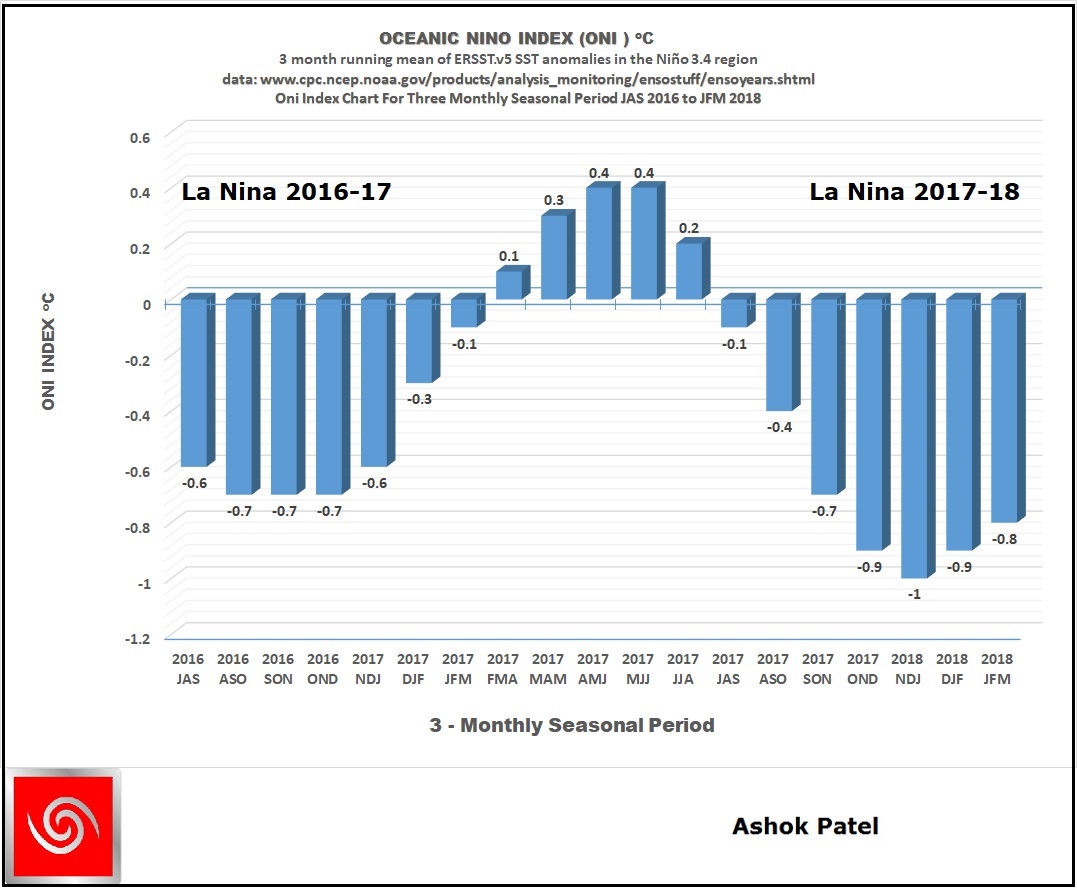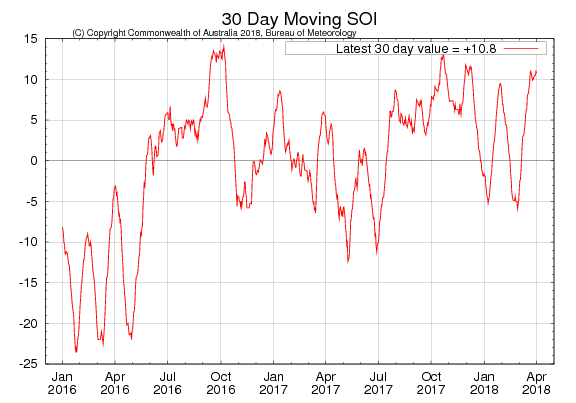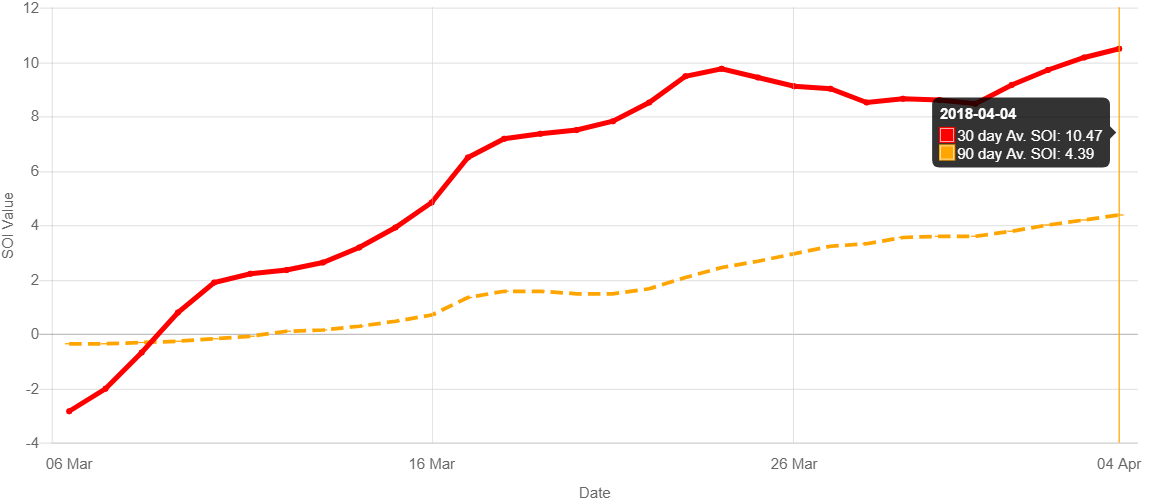ENSO Status on 4th April 2018
Full-fledged La Nina Event Has Developed At The End Of March 2018.
માર્ચ આખરના વિધિવત “લા નીના” પ્રસ્થાપિત થયું.
The ONI is based on SST departures from average in the Niño 3.4 region, and is a principal measure for monitoring, assessing, and predicting ENSO. Defined as the three-month running-mean SST departures in the Niño 3.4 region. Departures were based on a set of improved homogeneous historical SST analyses (Extended Reconstructed SST – ERSST.v4) and have now been updated to further improved homogeneous historical SST analyses (Extended Reconstructed SST – ERSST.v5). Explanation about ERSST.v5 is given here.
The SST reconstruction methodology is described in Huang et al., 2015, J. Climate, vol. 28, 911-930.
CPC uses current Climatology based on 1986-2015 which has been changed late last year from base years 1981-2010. Explanation about Climatology base years change is given here.
NOAA Operational Definitions for El Niño and La Niña, El Niño: characterized by a positive ONI greater than or equal to +0.5ºC. La Niña: characterized by a negative ONI less than or equal to -0.5ºC. By historical standards, to be classified as a full-fledged El Niño or La Niña episode, these thresholds must be exceeded for a period of at least 5 consecutive overlapping 3-month seasons.
CPC considers El Niño or La Niña conditions to occur when the monthly Niño3.4 OISST departures meet or exceed +/- 0.5ºC along with consistent atmospheric features. These anomalies must also be forecast to persist for 3 consecutive months.
Last five ONI Index are SON 2017 -0.7ºC, OND 2017 -0.9ºC, NDJ 2018 -1.0ºC, DJF 2018 -0.9ºC and JFM 2018 -0.8ºC. Since, five consecutive 3-monthly seasonal ONI Index are less than or equal to -0.5ºC it fulfills the NOAA Operational definition of a La Nina at the end of March 2018.
La Nina event 2017-18 has officially evolved at the end of March 2018 (JFM 2018). This La Nina event is the second consecutive La Nina event, the other being 2016-17 La Nina event that ended at the end of January 2017 (NDJ 2017).
Latest Oceanic Nino Index (ONI) Graph Showing Official La Nina Event Has Evolved JFM 2018
The Table below shows the monthly SST of Nino3.4 Region and the Climate adjusted normal SST and SST anomaly for last two years. Climate Base 1986-2015. ERSST.v5
Period Nino3.4 ClimAdjust YR MON Temp.ºC Temp.ºC ANOM ºC 2016 2 29.00 26.66 2.34 2016 3 28.90 27.21 1.70 2016 4 28.73 27.73 0.99 2016 5 28.24 27.85 0.39 2016 6 27.70 27.65 0.05 2016 7 26.82 27.26 -0.44 2016 8 26.28 26.91 -0.63 2016 9 26.15 26.80 -0.65 2016 10 25.98 26.75 -0.78 2016 11 25.95 26.75 -0.80 2016 12 26.10 26.65 -0.55 2017 1 26.12 26.45 -0.33 2017 2 26.68 26.66 0.02 2017 3 27.33 27.21 0.12 2017 4 28.04 27.73 0.30 2017 5 28.30 27.85 0.45 2017 6 28.06 27.65 0.41 2017 7 27.54 27.26 0.28 2017 8 26.70 26.91 -0.21 2017 9 26.29 26.80 -0.51 2017 10 26.15 26.75 -0.60 2017 11 25.74 26.75 -1.01 2017 12 25.62 26.65 -1.04 2018 1 25.58 26.45 -0.88 2018 2 25.98 26.66 -0.68 2018 3 26.44 27.21 -0.77
CPC considers El Niño or La Niña conditions to occur when the monthly Niño3.4 OISST departures meet or exceed +/- 0.5°C along with consistent atmospheric features. These anomalies must also be forecast to persist for 3 consecutive months.
Southern Oscillation Index
As per BOM, Australia:
The 30-day Southern Oscillation Index (SOI) to 2nd April 2018 was +10.8, while the 90-day SOI remains within the neutral range.
Sustained positive values of the SOI above +7 typically indicate La Niña while sustained negative values below −7 typically indicate El Niño. Values between about +7 and −7 generally indicate neutral conditions.
Recent (preliminary) Southern Oscillation Index values as per The Long Paddock – Queensland Government.
SOI Monthly graph up to March 2018 as per The Long Paddock – Queensland Government.
30 Days average SOI was +8.48 at the end of March 2018 and was +10.47 on 4th April 2018 as per The Long Paddock – Queensland Government and 90 Days average SOI was +4.39.
Summary by: Climate Prediction Center / NCEP Dated 2nd April 2018
ENSO Alert System Status: La Niña Advisory
La Niña conditions are present.*
Equatorial sea surface temperatures (SSTs) are below average across the central and eastern Pacific Ocean.
A transition from La Niña to ENSO-neutral is most likely (~55% chance) during the March-May season, with neutral conditions likely to continue into the second half of the year.
As per BOM -Australia 27th March 2018
ENSO outlooks
All eight of the surveyed international climate models indicate equatorial Pacific sea surface temperatures are likely to continue warming over the coming months. While two models suggest NINO3.4 will meet La Niña thresholds in April, a neutral ENSO is the most likely outcome for the remainder of the southern hemisphere autumn and winter. The Bureau’s model predicts the equatorial Pacific will continue to warm throughout winter but remain within the neutral range.

Ashok Patel’s Final Note:
Using NOAA Criteria A Full Fledged La Nina has evolved in March 2018 with 3-monthly season JFM 2018 at -0.8ºC
Last five ONI Index are SON 2017 -0.7ºC, OND 2017 -0.9ºC, NDJ 2018 -1.0ºC, DJF 2018 -0.9ºC and JFM 2018 -0.8ºC. Since, five consecutive 3-monthly seasonal ONI Index are less than or equal to -0.5ºC it fulfills the NOAA Operational definition of a La Nina at the end of March 2018.
La Nina event 2017-18 has officially evolved at the end of March 2018 (JFM 2018). This La Nina event is the second consecutive La Nina, the other being 2016-17 La Nina event that ended at the end of January 2017 (NDJ 2017).
It is surprising that BOM Australlia on 27th March 2018 says “El Niño-Southern Oscillation neutral”
અશોક પટેલ ની નોંધ :
NOAA માપદંડ મુજબ વિધિવત La Nina 2018 માર્ચ આખરે પ્રસ્થાપિત થયું.
સળંગ 5 ત્રી-માસિક સીઝન માં ONI ઈન્ડેક્સ -0.5°C અથવા તેનાથી નીચે રહેલ છે, જેમ કે SON 2017 at -0.7°C, OND 2017 at -0.9°C, NDJ 2018 at -1.0°C, DJF 2018 at -0.9°C and JFM 2018 at -0.8°C. એટલે NOAA માપદંડ મુજબ વિધિવત La Nina 2018 માર્ચ આખરે પ્રસ્થાપિત થયું.
ઓસ્ટ્રેલિયા ની BOM સંસ્થા ના 27 માર્ચ 2018ના બુલેટિન મુજબ ENSO ન્યુટ્રલ કન્ડિશન છે. તે તારણ સાથે હું અસહમત છું.
All earlier updates are listed below:
Click here for Update “La Nina Event 2017-18 Expected To Commence At The End Of March”
Click here for Update “Three Consecutive 3-Monthly Seasons Have Oni -0.5ºC Or Below”
Click here for Update “ENSO Neutral Conditions Prevails”
Click here for Update “ENSO Neutral Conditions Prevails With JAS 2017 ONI Index At -0.2ºC”
Click here for Update “Theoretically El Nino Not Possible During 2017”
Click here for Update “Theoretically El Nino Not Possible During The Indian Southwest Monsoon 2017”




arvalli ma varasad no koi chanch che?
Evu fix na hoy.
aa badhu chances hoy.
Nikava ma aaje japtu padti
Sir gay kaale sanje Dahod jillana Garbada taluka ma 15 minute nu Zaptu padyu tu sir.
Aaje pan dahod maa gay kaal jevu vatavaran chhe. Vadalo chhe
Sir hve next update kyre krso???
Ane sir aa vatavaran varsad nu roj bapor pchij km 1k aa 1k change thai jai che enu su reason roj 2 days thi apde rajkot ma baporna 3:30-4:00 thai tya akash akhu vadado thi chavai jai che to sir aa bapor pchij km avu vatavaran thai che plz jnava vinanti sir
Gai kale jawab aapel chhe
Sir aje khub j jakal hti ane chela 3 divas thi kutch ma thunderstorm thay se juda juda vistaro ma varsad pan pade se
Sir pachhu update kyare apso
Avata 48 kalakma havaman vibhag vala Amreli ane Rajkot vigere jilama varsad ni agahi ape 6e. Apnu mantavya shu 6e?
Marey je kahevanu hatu te 3rd April na kahel chhe.
સર આ વાતાવરણ હજી કેટલા દીવશ રહ છે.
11 sudhi
“Forecasts of Vertical Velocity or Precipitation”
Kem update thatu nathi…1st april pachhi bandh chhe…!!!???
Kya model ni vaat chhe ?
jovo http://www.monsoondata.org/wx/india.vv.html
namste sir.
najik na samayma vatavaranma sudharna koy sanket chhe k avu vatavaran yathavat rahse?
11 sudhi samjo
સર આજે તો વાદળો ટપકતા ટપકતા રહી ગયા અને વાયા એમપી નીકળી ગયા.
આજે બઉ ઉકળાટ હતો સર હમારે.
બફોરે અચાનક પવનો દક્ષિણ પૂર્વ ના થય ગયાતા અને સાંજે પાછો પશ્ચિમ નો થય ગયો. હાલ મા વાદળો દશ્રિણ પૂર્વ થી આવી રહ્યા છે.
સર&મિત્રો આજે અમારા વિસ્તાર માં તોરી&રામપુર આસપાસ માં જોરદાર પવન ની ગતિ સાથે લગભગ અડધો ઇંચ વરસાદ છે,,જિલ્લો અમરેલી તાલુકો વડિયા&કુંકાવાવ,,,
Sir aaje lalpur taluka na amuk gam ma saro aevo varsad padi gayo, sela ma pani vehta thay gaya…
આ વરસાદ આવવાનો હોય તેવો ઉકળાટ કેમ છે અશોકભાઈ રવિવારે ખુબ જ હતો આજે ઓછો છે માણાવદર,,,,,,,, શુ ફેરફાર છે????
Vatavaran ma asthirta raheshe em kahel chhe.
Sir i m Nilang Upadhyay aa mara papa na mathi hu comment kru chu km k mari comment ekoi btavtij nthi to enu karan su
Jyre tme post muko tyre comment 1st time kruto btave che ane pchi kru to nthi btavti mari comment to plz sir aa problem no hal apone
Ane hu ama post comment kru to load thai jai che maru Nilang Upadhyay vadu pn btavta nthi comment
So kindly request sir k aa problem solved kri apo ane aa thvanu karan su e jnava vinanti
Ek sathe vadhu comment karo etle Program ne em thaay ke a SPAM comment chhe etle te mari knowledge vagar sidhi SPAM folder ma comment jaay.
Biju ke Name ma pan ghadik Anil Upadhyay ane ghadik Nilang Upadhyay tarikhe post karo. IP address ekaj hoy etle tamaru post SPAM samji ne Automatic Kachara Topli ma comment jaay chhe.
Comment karya pachhi raah jovani. Ypgya time maley tyare reply karu chhu.
Te darmiyan bey tran var fari comment karo etle hoy etli badhi comment SPAM ma jaay.
Haathe kari ne tamoye evu karyu chhe.
Sir morbi baju kevu vatavaran rahse 11 mi sudhi
FIx area maate koi aagahi nathi aapi.
Genral vaat karel chhe ke vatavaran ma asthirta raheshe.
Varsad bhari dye khetru bara pani nikdi gya haju varse
Lalpur ,babrzar
Sir at this time means in April only winds are blowing from South West at around 15 to 20 Kms per hour. What is the reason behind this? Is there any depression or something around Gujarat or what?
NO depression near Gujarat.
Aa Je kevu vatavaran jamnagar dist ma rahse
Vadado nu fodu bandhanu chhe Devbhumi/Jamnagar District baju
La nino thi samanya karta vathu varsad that?
Evu badha maaney chhe. India na kya vistar ne vadhu faaydo thaay te haju sudhi reasearch nathi thai.
sir
aa vatavaran ke zapta ne lithe kai monsoon ma kai asar thay??
No